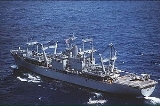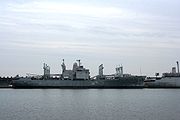
Charleston class amphibious cargo ship
Encyclopedia
The Charleston-class amphibious cargo ships were a class of amphibious cargo ship
Amphibious cargo ship
Amphibious cargo ships were U.S. Navy ships designed specifically to carry troops, heavy equipment and supplies in support of amphibious assaults, and to provide naval gunfire support during those assaults. A total of 108 of these ships were built between 1943 and 1945—which worked out to an...
s in service with the United States Navy
United States Navy
The United States Navy is the naval warfare service branch of the United States Armed Forces and one of the seven uniformed services of the United States. The U.S. Navy is the largest in the world; its battle fleet tonnage is greater than that of the next 13 largest navies combined. The U.S...
. These ships served in Amphibious Readiness Groups between 1968 and 1994. The ships were the last amphibious cargo ships built for the U.S. Navy, their role having been taken over by amphibious transport docks.
Service
Built in the late 1960s, these ships participated in the Vietnam WarVietnam War
The Vietnam War was a Cold War-era military conflict that occurred in Vietnam, Laos, and Cambodia from 1 November 1955 to the fall of Saigon on 30 April 1975. This war followed the First Indochina War and was fought between North Vietnam, supported by its communist allies, and the government of...
. Four of the five ships in the class had been transferred to the reserve fleet
Reserve fleet
A reserve fleet is a collection of naval vessels of all types that are fully equipped for service but are not currently needed, and thus partially or fully decommissioned. A reserve fleet is informally said to be "in mothballs" or "mothballed"; an equivalent expression in unofficial modern U.S....
in the late 1970s and early 1980s. The need for additional sealift
Sealift
Sealift is a term used predominantly in military logistics and refers to the use of cargo ships for the deployment of military assets, such as weaponry, vehicles, military personnel, and supplies...
capacity resulted in all four being returned to the active fleet in 1982. They are among the first Navy ships to have a fully automated main propulsion plant (600-pound pressure with superheat, known as a "Super Six."). The lead ship of the class, was decommissioned in 1992, and was joined by in November 1992. The remaining ships were decommissioned in 1994. All ships are mothballed for possible activation in the future.
Design
The assigned mission of the amphibious cargo ship was to transport and land combat equipment and material with attendant personnel in an amphibious assault. To optimize their capability for combat loadingCombat loading
Combat loading is a method of loading cargo into the ships that will carry it to the site of an amphibious landing. It gives primary consideration to the ease and sequence with which troops, equipment, and supplies can be unloaded ready for combat, rather than to the efficient use of cargo...
, they provided considerable flexibility in cargo stowage methods. The cargo elevator
Elevator
An elevator is a type of vertical transport equipment that efficiently moves people or goods between floors of a building, vessel or other structures...
s servicing holds 1, 3, and 4 make all categories of supplies and all levels available simultaneously to either the main deck or the helicopter
Helicopter
A helicopter is a type of rotorcraft in which lift and thrust are supplied by one or more engine-driven rotors. This allows the helicopter to take off and land vertically, to hover, and to fly forwards, backwards, and laterally...
platform. Use of the ship's forklifts and pallet transporters speed the maneuvering of cargo in the holds and enable delivery to various debarkation stations via the main deck passageways, which run the length of the ship. The arrangement and quantity of booms and cargo elevators make it possible to simultaneously embark/debark vehicles and cargo.
Vehicles in upper stowage spaces can be embarked/debarked through the hatches with cargo booms, while pallets are embarked/debarked in lower stowage spaces by elevators. The main deck hatch of hold 2 is unobstructed and can be opened for embarking/debarking of vehicles without the delay of unloading landing craft stowed on the hatch. Hold 4 is well suited for high priority cargo because of its direct access to the flight deck
Flight deck
The flight deck of an aircraft carrier is the surface from which its aircraft take off and land, essentially a miniature airfield at sea. On smaller naval ships which do not have aviation as a primary mission, the landing area for helicopters and other VTOL aircraft is also referred to as the...
or main deck via elevator number 5.
Ships

See also
- List of attack cargo ships of the United States Navy (AKA)
- List of amphibious cargo ships of the United States Navy (LKA)

